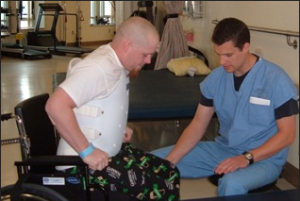A new, two-part series intended to be a starting point for a basic understanding of the  normal functions of the spinal cord and how they might change after an injury, has just been released. It’s a publication of the Model Systems Knowledge Translation Center (MSKTC), which has collaborated with 14 of the best SCI research hospitals across the nation, to put the information into plain language that everyone can easily understand and apply in their everyday life.
normal functions of the spinal cord and how they might change after an injury, has just been released. It’s a publication of the Model Systems Knowledge Translation Center (MSKTC), which has collaborated with 14 of the best SCI research hospitals across the nation, to put the information into plain language that everyone can easily understand and apply in their everyday life.
While it is not possible to cover everything in a single handout, these two factsheets are a fast way to get some of the most important information on the basics of SCI.
Here is a brief summary of each factsheet:
Part 1 – The Body Before and After Injury
A clear, easy to follow diagram shows the five sections of the spine: Cervical (at the top), Thoracic, Lumbar, Sacral and Coccygeal ( at the bottom). The bony spine protects the spinal cord, which is the nerve pathway that allows the body and brain to communicate. The factsheet explains how the nervous system operates through motor function (muscle movement), sensory function (ability to feel things) and autonomic function (reflex functions such as blood pressure).
There are also plain-English answers to such questions as:, “What does the spinal cord do? What are common causes of spinal cord injury? What is level of injury? What is the difference between complete and incomplete injury? What is paralysis? What is tetraplegia and paraplegia?”
Part 2 – Recovery and Rehabilitation
This factsheet covers the most basic information about recovery and rehabilitation. It supplies straightforward answers to such questions as, “Can paralysis caused by SCI be reversed? How much improvement will I gain? What is my role in rehab? What advice can be offered from other people with SCI about rehab?” (this sections includes a link to Facingdisability.com).
“What are my functional goals?” is a question that introduces a very helpful chart that details the daily activities that most people with SCI can expect to manage, depending on the level of their injury, and the equipment they will need to accomplish those tasks.
Here’s a preview of part of the chart:
Keep in Mind…
The impact of a spinal cord injury is different for everyone, so it is impossible to answer questions in a way that applies to all individuals. These fact sheets give clear answers some of the most common questions.
Here are links to both the “Understanding Spinal Cord Injury” fact sheets.
Part 1: The Body Before and After Injury
Part 2: Recovery and Rehabilitation
Here’s a link to all the MSKTC “Spinal Cord Injury Fact Sheets”. They offer solidly researched, expert information you can trust.

Leave a Reply